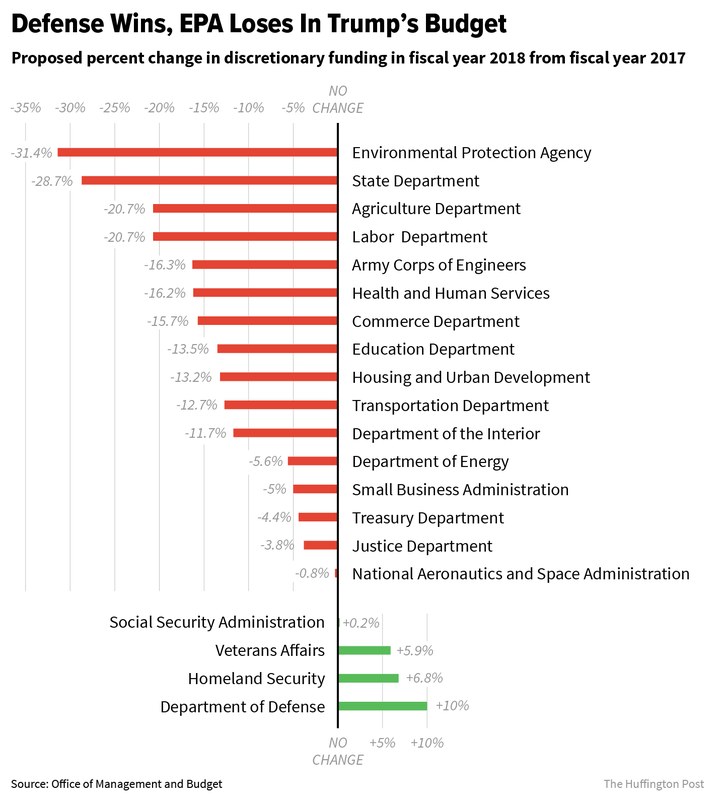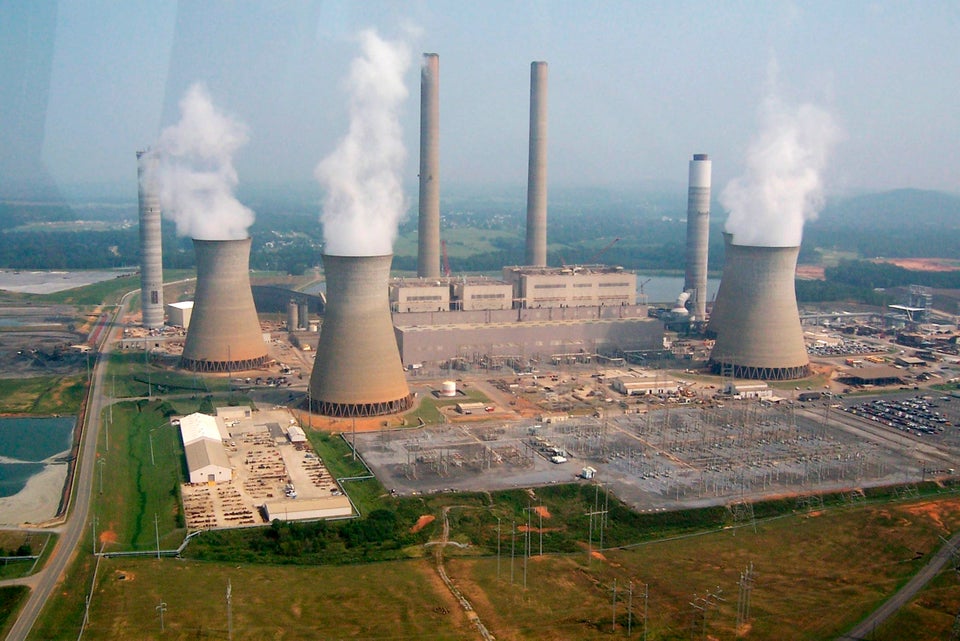Federal funding to combat man-made global warming, scrub pollution, and research energy and the Earth’s climate disappeared in a budget outline that the White House put forward on Thursday.
The budget proposed steep and sweeping cuts across the executive branch. But the Environmental Protection Agency suffered the biggest blow, losing 31 percent of its funding. The agency is seen as the spear tip of the “administrative state” President Donald Trump vowed to dismantle.
The Trump administration’s preliminary skinny budget, released at 7 a.m. on Thursday, reduces the EPA funding from $8.2 billion to $5.7 billion and guts climate change programs across a slew of other federal agencies.
“We’re not spending money on that anymore,” Mick Mulvaney, director of the Office of Management and Budget, said of efforts to prevent climate change from worsening. “We consider that to be a waste of your money.”
The new budget eliminates funding for regional cleanup efforts in the Great Lakes, the Long Island Sound and Chesapeake Bay, for example, and defunds the Clean Power Plan, the federal government’s only major effort to reduce carbon emissions from the utility sector. Trump is expected to sign an executive order further weakening the Clean Power Plan as early as this week. The order will reportedly instruct the EPA to begin rewriting the plan, which would have reduced the greenhouse gas emissions from the utility sector ― the biggest industry emitter in the U.S. ― by 30 percent below 2005 levels by 2030.
The move essentially kneecaps U.S. participation Paris Agreement on climate change that 195 countries signed.

The budget dramatically shrinks the State Department. It eliminates spending on the U.S. Agency for International Development’s Global Climate Change Initiative and ceases payments to the United Nations’ climate change programs, such as the Green Climate Fund ― a critical tool for getting poorer countries to reduce their carbon footprint.
At the EPA alone, the budget axes funding for Energy Star, the popular, voluntary program that boosts energy efficiency in appliances, electronics and buildings. It also ends grants for ozone pollution cleanup and infrastructure assistance to Alaska Native villages and people on the Mexican border, along with international climate programs, climate change research and partnership initiatives. It “reins in” spending on the toxic waste cleanup Superfund, lowballing the account by $330 million.
In all, the proposed budget terminates more than 50 EPA programs. The cuts go further than the 25 percent reduction originally proposed in a draft of the budget earlier this month. Administrator Scott Pruitt ― an opponent of the agency’s core mission who previously sued the EPA 13 times to block environmental regulations ― failed to persuade Trump to leave the budget at $7 billion, according to The New York Times. Instead, the president axed more.
The budget proposes adding $4 million to the State Revolving Funds programs that provide low-interest loans for investments in water and sanitation infrastructure, increasing it to $2.3 billion. It also leaves in place $20 million for rebuilding water infrastructure ― an issue that reached crisis pitch with the lead poisoning in Flint, Michigan, last year.
Gina McCarthy, who served as EPA administrator until January, issued a scathing response to the budget plan.
“Literally and figuratively, this is a scorched earth budget that represents an all out assault on clean air, water, and land,” she said in a statement. “You can’t put ‘America First’ when you put the health of [its] people and its country last.”

The EPA’s budget last year was already well below its 2010 peak of nearly $10.3 billion, and critics of the cuts said the agency requires more funding, not less.
“The problem at EPA is not that it has too much power, but that it doesn’t have enough resources to do an adequate job of protecting our air, water and irreplaceable natural resources,” Ken Cook, president of the nonprofit Environmental Working Group, said in a statement. “This is not a philosophical debate about regulations or ‘deconstructing government,’ but about our health, our safety and the world we’re going to leave to our children.”
Trump pledged to boost the U.S. economy by shredding environmental rules he blames for holding back businesses. He stacked his Cabinet with fossil fuel allies and climate science deniers, including Pruitt, who ignited a firestorm when he said on national TV that he doesn’t believe carbon dioxide emissions cause global warming. Already, the Trump administration has lifted regulations to protect streams and waterways from toxic pollution and scrapped a rule requiring oil and gas drillers to report methane leaks. But the budget proposal marks the first time he has put vague, sometimes contradictory campaign promises into clear, black-and-white spending priorities.
The Department of Energy’s climate and renewables research took crippling hits. Trump proposed eliminating the Advanced Research Projects Agency-Energy, known as ARPA-E, a critical program responsible for major breakthroughs in energy research, and the Advanced Technology Vehicle Manufacturing Program. “[T]he private sector is better positioned to finance disruptive energy research and development and to commercialize innovative technologies,” the budget reads.
The department’s Office of Sciences, a key funder of research, loses $900 million and must abide by new directives to limit research into energy efficiency, renewables, nuclear energy, electrical grid technology and fossil fuels to “early-stage applied energy research and development activities where the Federal role is stronger.”
The budget does, however, provide $6.5 billion to clean up radioactive waste from energy research and nuclear weapons production ― money that’s also earmarked for modernizing aging nuclear facilities.
The National Oceanic and Atmospheric Administration, a division of the Department of Commerce, suffered major blows. The budget leaves environmental satellite programs in place only to help with weather forecasting and cuts back the use of satellites to monitor polar icecap melt. It appears to maintain funding to the National Weather Service, which Trump tweeted support for during a blizzard this week. However, it zeroes out over $250 million in targeted grants for coastal and marine management, research and education though the Sea Grant, which funds conservation efforts in the Great Lakes and on the coasts.
“Literally and figuratively, this is a scorched earth budget that represents an all out assault on clean air, water, and land.”
- Gina McCarthy, former EPA administrator
“The Trump administration’s proposed budget would cripple the science and technology enterprise through short-sighted cuts to discovery science programs and critical mission agencies alike,” former New Jersey Congressman Rush Holt, now chief executive of the American Association for the Advancement of Science, said in a statement. “The administration’s cuts threaten our nation’s ability to advance cures for disease, maintain our technological leadership, ensure a more prosperous energy future, and train the next generation of scientists and innovators to address the complex challenges we face today and in the future.
The Department of the Interior ― which oversees 500 million acres of land or 20 percent of the U.S. landmass ― saw 12 percent of its budget evaporate, reducing it to $11.6 billion. That includes money to restore abandoned mining lands and some National Wildlife Refuge fund payments to local governments. The office that buys public lands would lose $120 million. Funding for National Historic Sites would be wiped out. It’s unclear whether that would affect National Historic Parks, such as the those located in Harpers Ferry, West Virginia, and at inventor Thomas Edison’s old home in New Jersey.
At the National Aeronautics and Space Administration, funding for robotic satellites, education and Earth science programs shrank as the White House seeks a “focused, balanced” approach that “supports the priorities of the science and applications communities.”
“The Trump budget deliberately eviscerates enforcement of our environmental laws — which would let many law-breakers operate with little fear of prosecution — and dismantles programs that support our most vulnerable communities from environmental hazards,” said Trip Van Noppen, president of the environmental nonprofit Earthjustice, in a statement. “We call on members of Congress to stand up for the communities they represent and vigorously oppose this irresponsible plan.”
This article has been updated with more details and reactions to the budget plan.


